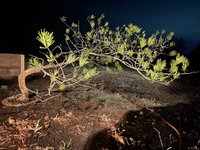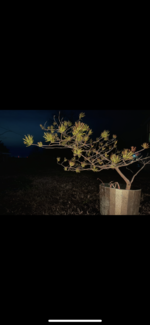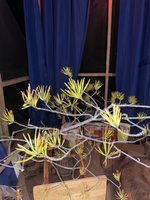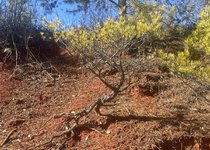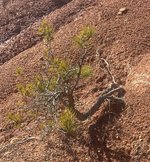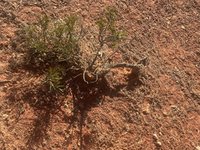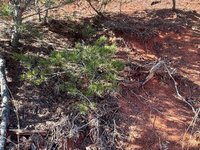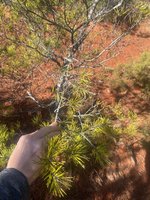You are using an out of date browser. It may not display this or other websites correctly.
You should upgrade or use an alternative browser.
You should upgrade or use an alternative browser.
Help identifying two pines
- Thread starter Dcj6311
- Start date
Dav4
Drop Branch Murphy
- Messages
- 13,111
- Reaction score
- 30,189
- USDA Zone
- 6a
Hard to tell from photos, but assuming a native 2 needled pine species, I'd guess Virginia pine- https://plants.ces.ncsu.edu/plants/pinus-virginiana/. Close ups of the needles/ needle fascicles may help with ID.
Dcj6311
Seedling
I can get more pictures tomorrow but yes I’ve heard it was Virginia pine and someone else said pitch pine? If it’s Virginia pine would it be safe to treat it as a Japanese black pine? I’ve saw a few videos and other threads of people saying this.
I appreciate your feedback
I appreciate your feedback
Attachments
19Mateo83
Masterpiece
Welcome to the nut house and hello from charlotte! Definitely looking like a Virginia pine but closer inspection of the needles is needed as mentioned above. Do the needles look like they twist? If so that’s another characteristic of a Virginia pine. The one in the last picture looks like it may be affected by dothistroma needle blight. You can spray it with a copper based fungicidal spray now and again in spring when new needles emerge. It should start filling out once you knock the fungus back. Here’s a close up of a Virginia pine I found that looked the same.
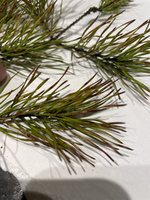

Dcj6311
Seedling
Dcj6311
Seedling
10-4 thanks man I posted some more pictures from trees that were on the same slope as them some of the roots are to spread out but others actually have a nice compact rootball. It’s a clay slope with erosion issues so is it typical for a pine growing in those conditions to get needle blight? I’m a surveyor in roadway construction and these trees fall right inside the clearing limits so I have to try and save them or a dozer will be pushing them into a burn pile in the next few months so if anyone has advice on how to handle them that would be greatWelcome to the nut house and hello from charlotte! Definitely looking like a Virginia pine but closer inspection of the needles is needed as mentioned above. Do the needles look like they twist? If so that’s another characteristic of a Virginia pine. The one in the last picture looks like it may be affected by dothistroma needle blight. You can spray it with a copper based fungicidal spray now and again in spring when new needles emerge. It should start filling out once you knock the fungus back. Here’s a close up of a Virginia pine I found that looked the same.
View attachment 523753
Dcj6311
Seedling
Also
these are right at nc/sc line a a couple miles off 85 so if you like any enough for a 45 minute drive they’re free game10-4 thanks man I posted some more pictures from trees that were on the same slope as them some of the roots are to spread out but others actually have a nice compact rootball. It’s a clay slope with erosion issues so is it typical for a pine growing in those conditions to get needle blight? I’m a surveyor in roadway construction and these trees fall right inside the clearing limits so I have to try and save them or a dozer will be pushing them into a burn pile in the next few months so if anyone has advice on how to handle them that would be great
bwaynef
Masterpiece
Free game, you say? (That red clay is formidable when it comes to collecting pines though.)
Dcj6311
Seedling
Yeah it’s a little bit longer drive from Clemson thoughFree game, you say? (That red clay is formidable when it comes to collecting pines though.)
bwaynef
Masterpiece
The basics of aftercare w/ collected trees are drainage, controlled watering, and complete immobilization of the tree so that roots can grow quickly. While I wouldn't go to any length to bareroot it, I'd also not expect the red clay all over the upstate and in your pictures to do a whole lot for the health of the tree once potted. Keep as much root as you can. Leave some portion of it untouched and intact, and get rid of most of the clay.
Good luck.
Good luck.
Brian Van Fleet
Pretty Fly for a Bonsai Guy
rockm
Spuds Moyogi
Virginia pine. Ditto Brian's comment on getting them out of red clay. Not easy to do. In those conditions, they tend to send out long running roots, like tens of feet long, with all the feeders at the ends. The long stringy roots in the bottom photo suggest that's the case here. Erosion has exposed the character of the roots remaining in the ground. What you see above ground likely continues below. Collecting them in clay typically results in self-bare rooting and subsequent difficulties in recovery, IF they recover at all.
MaciekA
Shohin
Virginia pine is in the contortae grouping (shore, lodgepole, jack, virginia, etc). I have some experience with a few collections of the other contorta (shore + lodgepole) out of conditions that were pretty terrible for collection -- conditions here often suck for conifer collecting. Clays, very loose volcanic sand, beach sand, lava beds, moss on lava. Either a super dense clay or else it falls apart easily, and you're definitely bare rooting either way. For me success has been from:
- Heavily perforated non-shallow pot whose volume is otherwise as small as the roots will fit as @Brian Van Fleet mentioned, with either pumice or lava or both. I seem to have nicer recovery results in lava overall especially after the roots start to catch up (YMMV). Position highest root density at half the soil depth, secure canopy / trunk system to the container for no swaying/levering. If resulting pot is prone to flexing/shear, stiffen it with wooden boards/whatever, esp. if you will be doing the bonsai shuffle.
- Bottom heat to hit the ground running in the spring with some working roots (pot bottom at 85F, keep canopy cold). Regrows roots well.
- Full sun when growing season returns, but dial back light after noon-ish. Once the shoots are hardened and the tree gives the sign it's been able to pull water during needle extension, it's through the firy hoop, dial up sun intensity for good after that.
- Letting soil dry out to some fairly deep depth during the early months (check by poking around) before re-watering
TLDR: I think this species is very similar to other contortas. Use an airy small container (not shallow), tree well secured and roots deeper into the soil, use lava/pumice, use continuous bottom heat if collected in cold season, give full sun but control daytime until hardened.
- Heavily perforated non-shallow pot whose volume is otherwise as small as the roots will fit as @Brian Van Fleet mentioned, with either pumice or lava or both. I seem to have nicer recovery results in lava overall especially after the roots start to catch up (YMMV). Position highest root density at half the soil depth, secure canopy / trunk system to the container for no swaying/levering. If resulting pot is prone to flexing/shear, stiffen it with wooden boards/whatever, esp. if you will be doing the bonsai shuffle.
- Bottom heat to hit the ground running in the spring with some working roots (pot bottom at 85F, keep canopy cold). Regrows roots well.
- Full sun when growing season returns, but dial back light after noon-ish. Once the shoots are hardened and the tree gives the sign it's been able to pull water during needle extension, it's through the firy hoop, dial up sun intensity for good after that.
- Letting soil dry out to some fairly deep depth during the early months (check by poking around) before re-watering
TLDR: I think this species is very similar to other contortas. Use an airy small container (not shallow), tree well secured and roots deeper into the soil, use lava/pumice, use continuous bottom heat if collected in cold season, give full sun but control daytime until hardened.
Potawatomi13
Imperial Masterpiece
Seconded on bottom heat !
!
Similar threads
- Replies
- 0
- Views
- 166

